|
Bee
Balm: Loves shady hillsides and creek banks. Blooms
June-July. This one was in the Otter Creek Wilderness Area,
MNF, WV.
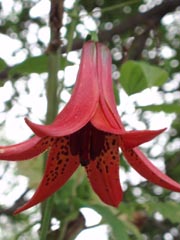
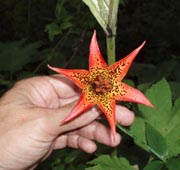
Gray's
Lily (Lilium grayii): Deep Red. Petals do not bend
back as much as others in this genus. Single flowers up to
clusters of 4. Found in the mountains of VA, TN and SC.
Location: AT - Tar Jacket Rodge, GWNF, VA. |
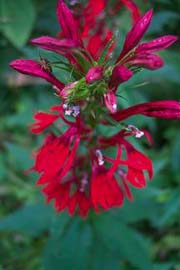
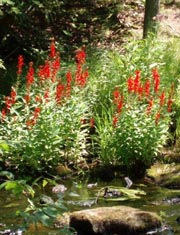
Cardinal Flower (Lobelia
cardinalis):
Oddly attractive. Grows along streams and in wet areas.
Blooms in summer. Location: Long Pond Trail, GRSF, MD.
British Soldiers (Cladonia
cristatella): This really isn't a flower but a
diminutive, colorful lichen usually growing on rocks with
other species. This one was seen in Dolly Sods, MNF, WV. |
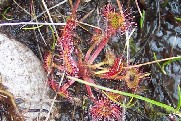
Round-leaved Sundew (Drosera
rotundifolia L.): This minute plant (less than
2 inches in height) is carnivourous. Insects get stuck to
the apparent drops of dew and are digested in place. It does
produce a simple white flower atop a central stalk.
Location: All along the wet spots of Dobbin Grade, Dolly
Sods North, MNF, WV.
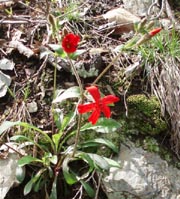
Fire Pink (Silene
virginica): Note the double toothed petals. Blooms in
open woods and rocky areas April to June. Location: AT,
James River Wilderness along the James River cliffs.
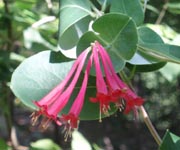
Trumpet
Honeysuckle (Lonicera sempervirens): Brilliant red
with yellow stamens. An attractive vine with evergreen
tendencies. parallel leaves behind flower clusters fuse to
form one. Location: Sugarloaf Mt, MD.
|
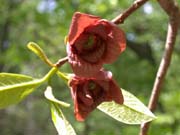
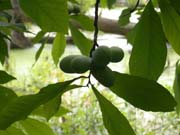
Pawpaw ( Asimina triloba): Dark red to maroon
flowers, 9 inch eliptical leaves. Tree grows to 20 feet.
Found in moist forests and flood plains. The fruit is
edible. Location: Harpersferry, WV. Photos by Ken Clark.
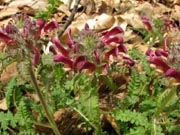
Wood Betony
or Lousewort (Pedicularis canadensis): Also found in
yellow. In the Snapdragon family. Blooms in early spring.
Location: Overall Run area, SNP, VA. Photo by Ken Clark. |
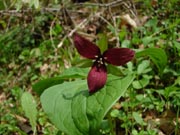
Red
Trillium (Trillium erectum). The first Trillium to
bloom in the region. Also known as Stinking Benjamin,
Stinking Willie and Wake-Robin. There are pale yellow and
white varients as well. Do not confuse these with the White
Trillium. Photo by Patrick Roberts. Location: Allegheny Tr,
WV.
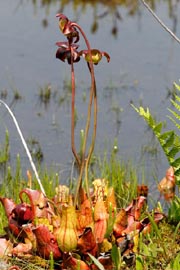
Northern
Pitcher Plant (Sarracenia purpurea): Carnivorous!
Height 8 to 24 inches. Leaves up to 12 inches. Each plat has
a large leathery crimson flower with 5 petals dangling over
the basal leaves. Leaves veined deeply red, inflated and in
the shape of a pitcher. The flower attracts insects which
fall into the "pitchers" which are partially full with
water. Inverted hairs on the leaf surface prevent their
escape. The plant extracts the nutrients from the water as
the insect decomposes. Photo by Marc Shaffer. |

